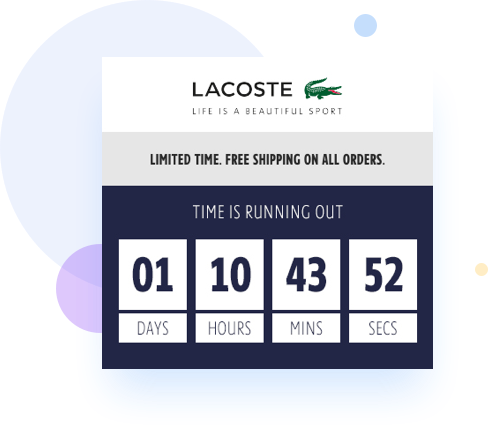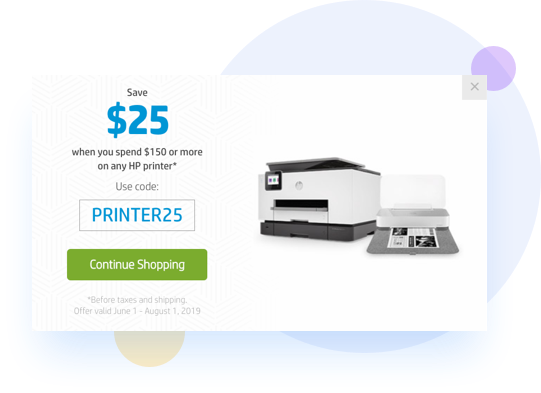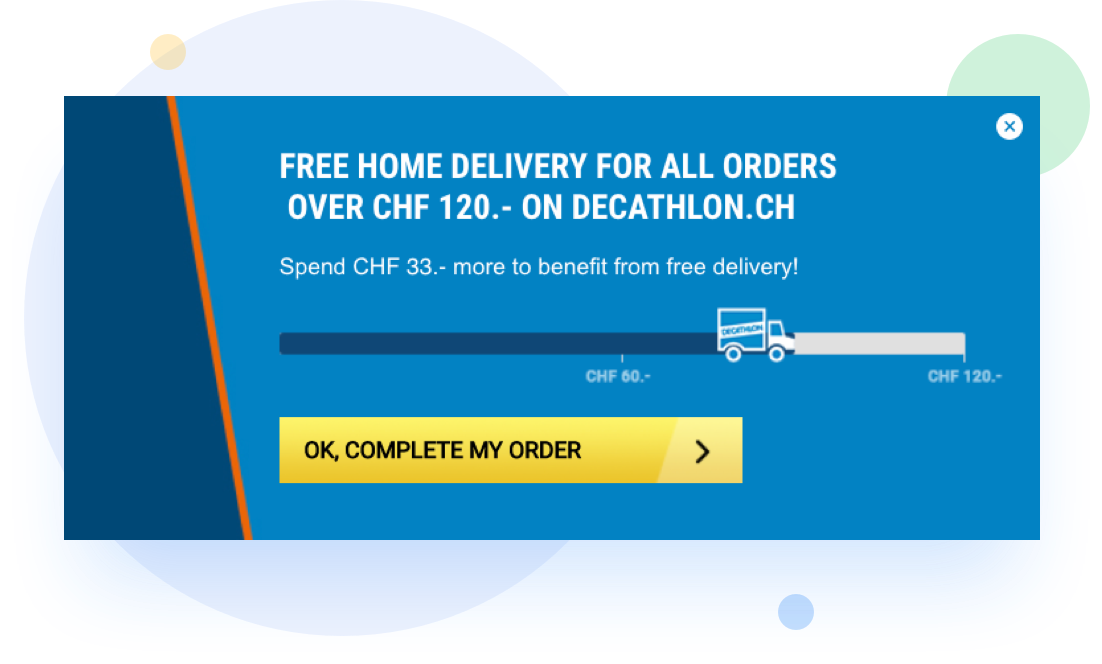Conversion Rate Optimisation Services
You work hard to attract shoppers to your website. SaleCycle’s conversion rate optimisation features help you to turn more visitors into customers.
Using customer data, we help you create a personalised and more persuasive customer journey that makes it easier for people to make a purchase.
Features
Countdown Timers
Provide a helpful dose of urgency and help persuade shoppers to buy before it’s too late.
add urgency to the purchase process
Voucher Codes
Highlight key offers, and provide compelling incentives for customers to convert.
drive conversions with targeted offers
Progress Bars
Encourage conversions by showing someone how close they are to purchase.
let them know how close they are
Product Trends
Add urgency and speed up conversions by showing key information on product popularity.
add social proof to drive conversions
Conversion Rate Optimisation Services – CRO Specialists
SaleCycle conversion rate optimisation services are carried out by specialists who use millions of daily tracked user journeys in a variety of industries to make data-driven decisions. Using customer data you can create a meaningful and personalised customer journey using a selection of conversion rate optimisation tools. Below is a suite of CRO services we offer to help you achieve your conversion goals:
Countdown Timers
A countdown timer allows you to communicate a sense of urgency and provides your customers with a deadline for a specific sale or delivery promotion. There’s a range of different ways this service can be presented on your website. You can show timers when the user lands on the page or when they display an exit intent or take a certain action, these are called triggers. There is also an option to convert busy sales traffic by optimising key offers on-site and through overlays or takeovers. Our client data highlighted that countdown timers during Black Friday Sales led to a 30% click increase along with a 200% increase in conversion rate.
Voucher Codes
Voucher codes can increase conversion rate and drive users to complete a goal. Placing promo codes on core pages allows you to accelerate your users towards the main offers and products, providing an extra incentive to complete their purchase. Voucher codes or promo codes can be integrated on-site but can also be used as a CRO tool when delivered in your basket abandonment emails. For example, our research found up to 20% of cart abandonments are influenced by price. Use this conversion rate optimisation service from SaleCycle and offer users promo codes to complete their purchase.
Progress Bars
The importance of conversion rate optimisation can be seen through increases in order value. CRO tools like progress bars draw a spotlight on shoppers’ qualifying process for extra benefits. For example, free delivery is one of the biggest influencers in the buying process, a progress bar can highlight how close they are to unlocking this benefit. You can use on-site triggers and also use them in your cart abandonment emails. It’s essential to launch these triggers at exactly the right time or at a certain user behaviour type, like exit intent.
Products Trends
Another powerful strategy to increase conversion rate is the use of product trends. We can launch messages that show information about customer browsing and behaviour, adding a sense of urgency. For example, you can boost conversions by telling customers how many others are browsing a product at the same time or using prompts like how many other customers have made a purchase or a booking. These messages can be shown in a number of different ways and at the right time, using customer behaviour data.
Our insights and millions of user journeys, which are tracked daily underpins every CRO service we offer. The expertise of our conversion rate optimisation specialists harness this data so that you can recover more online sales and turn more browsers into buyers.
Every feature we offer is tested and optimised to find the blend that performs best for our customers. We test everything, each element of cart abandonment emails, the send timing, and placement and copy used on Product Trends messages. All of this testing goes towards helping you to recover online sales.
What Is Conversion Rate Optimisation (CRO)?
Conversion Rate Optimisation, or CRO, is the action of increasing the proportion of website visitors who perform a desired action or goal. These actions can include requesting a demo, purchasing a product, adding an item to their cart, reducing cart abandonment, filling out a form or downloading an ebook. The appropriate actions will increase your conversion rate.
A conversion rate optimisation strategy involves analysing how your customers move through your site and understanding their journey. Where do they engage with your site and where are the pain points that stop them completing an action or desired goal.
Increasing your conversion rate allows you to deliver more qualified leads at a lower cost per acquisition (CPA). In turn, this means that you can gain greater value from your traffic.
You can apply specialist conversion rate tools all over your website, it’s important that all areas of your site are conversion-focused while offering a seamless user experience (UX).
Whether you’re in the retail or travel sectors, conversion rate optimisation tools can help you go from average conversion rates to winning highly effective revenue from all of the web traffic.
Visit the SaleCycle blog
for more information about what is CRO, as well as advanced conversion and digital marketing strategies and data reports.
How To Increase Your Website Conversion Rate?
A combination of conversion rate optimisation solutions can be used together to increase your conversion rate. SaleCycle has a number of CRO services which help to improve the online customer journey. Firstly, it’s important to do an in-depth analysis of the best performing pages on your website to make sure the copy is optimised, on brand, and you’re providing the right messages at the right time.
Drive Qualified Leads
The volume of traffic is important but it’s essential to gain quality traffic that can be converted. This is why creating relevant marketing campaigns targeting the right audience can help improve your conversion rate. The aim is to gain a high conversion rate at a low cost per click as opposed to low conversion rates at a high cost per click. The goal is to generate quality traffic through the right marketing channels at the right time and push these users further down the funnel using conversion rate optimisation techniques. When they become customers they can then enter your nurturing programme for repeat business.
Take a Personal Approach
You can increase your conversion rate using targeted and personalised content throughout the purchase funnel, which can be a great way to guide users through their online journey. Capturing information from your return visitors and existing customers such as customer behavioural trends during a session can be used to optimise their user experience to increase conversion rate. Using this data throughout the purchase funnel you can recommend products, provide customer service if they seem lost or provide ongoing communications such as browse abandonment, cart or SMS.
Implement An Abandonment Solution
As discussed above, using a shopping cart abandonment solution allows you to reconnect with your abandoners and encourage them to complete their purchase and therefore convert. There are several types of abandonment: cart, browse, booking and form. It can be a powerful tool to persuade visitors to return to their abandoned purchase and complete it. These emails or SMS must be well-timed, personalised and user-friendly, done correctly this can be a core solution in your conversion rate optimisation strategy and funnel.
Consider Mobile User Experience
Native SaleCycle data found 68% of online traffic came from mobile with 56% of online sales. The majority of online shoppers are browsing and buying on mobile so developing a great user experience on mobile is essential, however this can be a very different proposition to desktop. For example, smaller phone screens allow less space for design and key features, touchpoints and CTAs can be less precise and there are many more. Provide extra focus on your conversion rate optimisation strategy on mobile as that’s where most of your potential customers are engaging.
Use Customer Insights and Data
Analyse and test your website for any pain points and use your company data to spot strengths and weaknesses in the conversion funnel. Find areas of your site where people exit or show exit intent. You can even send out a quick survey for feedback on why they are leaving without converting, such as a one-click email survey. These insights could allow you to fix a major issue such as price checking, poor delivery options, website layout, slow site speed, not enough payment options and so on.
How Does Conversion Rate Optimisation Work?
There are two types of conversions and both can be optimised. A conversion happens when your user completes a goal, but each website has different goals depending on the niche. There are also different types of conversions called macro-conversions and micro-conversions.
Macro-Conversions
This is a larger goal completion or conversion, such as purchasing a product, requesting a demo or making a booking. We categorise these types of conversions as revenue based.
Micro-Conversions
This is a smaller goal completion, such as signing up for a newsletter, adding a product to the basket or creating an account. We categorise micro conversions
as engagement based.
Both types of conversions can be optimised in different ways but they both ultimately lead to revenue metrics when the solutions are used in conjunction with behaviour data. Working with over 600 clients in a wide range of sectors and with over a decade of experience we have a mass of data to make these decisions and increase your conversion rates.
Mobile Conversion Rate
Mobile accounts for 68% of online traffic and 56% of online sales. This means it’s important to optimise your conversion rate with a specific focus on mobile. mobile conversions are calculated the same as desktop but optimised using different tools and techniques. This is because the mobile user-journey and user-behaviour is very different on a mobile screen.
How Conversion Rate Optimisation Influences Better Business Decisions
Conversion rate is one of the most important factors of any business. Using CRO services to help track conversion rates allows businesses to monitor and analyse the effectiveness of their landing pages and product pages.
Understanding how many users are landing on your website and taking an action or highlighting where you users are seeing friction can help you either optimise or unblock areas of the website.
Businesses can also learn which areas of their website are the most popular (converting better) and funnel towards them areas. Using this data brands can understand what products are most popular at certain times or just how attractive the product or service is based on the information on the page.
It’s important to gain clarity on the areas of the website to work on first and by analysing conversion rate you can pinpoint where opportunities are being lost. From here you can optimise your in-demand products and boost your sales funnel.
How Do You Implement Conversion Rate Optimisation Services
Once our tag has been deployed a SaleCycle developer will create, test and deploy a bespoke file that will allow the campaign to function.
A key part of our conversion rate optimisation services is the design element. This is why, at SaleCycle, we pay special attention to the designs of our campaigns and how they are integrated into the visual identity of our customers. We therefore maximise conversion opportunities and ensure that Internet users become loyal customers.
This includes the visualisation of the email and on-site designs, as well as any amends requested. Designs are responsive for both mobile and desktop for each conversion product/feature. We will manage the entire implementation process testing all aspects of the conversion tools and campaigns before going live.
How Does CRO Improve SEO?
Conversion Rate Optimisation (CRO) and Search Engine Optimisation (SEO) work in tandem to drive results. In 2021 both should have a prime spot in your marketing strategy. CRO focuses on converting the traffic that SEO drives to your website. SEO means optimising your site to rank high in search results while CRO means optimising your website to encourage the users to complete a goal or take an action.
CRO done well, also means that traffic engages with the website more and increases behaviour metrics like average time on site, pages per session and bounce rate. While these don’t directly affect your ranking, they hit user experience signals, showing Google that your site or page is relevant for a specific query.
Website Conversion Rate Optimisation Strategy & Tips
At SaleCycle we have over 10-years of experience and we have worked with over 600 clients to acquire buckets of customer journey data for a wide range of sectors. So we would consider ourselves CRO experts. CRO planning is essential when creating your Black Friday sales strategies
or when preparing for the upcoming fashion ecommerce retail trends towards the end of the year.
Visit our blog, which is filled with conversion rate optimisation tips and helpful trend data for a wide selection of sectors to help drive value. For example, view ecommerce return rates by category to get a better understanding of each industry or research customer retention and its impact on sales. You can also find out the busiest retail months online, there’s plenty of helpful content available.
How Important Are Conversion Rate Optimisation Services?
Using our conversion rate optimisation services SaleCycle will deploy our CRO experts analyse your website. We do this by using step by step conversion rate optimisation best practices, which can accelerate your conversions and online sales.
1. Who are your customers
Who is part of your target audience and who is not. You can create bespoke marketing messaging that resonates with your users. When your customers read your on-site messaging and content you want to make sure your users go where you want them to go with a defined and simple user journey.
2. Customer feedback
Ask your customers to complete surveys but keep them very simple, you could use a one-click survey to gather insights into what your customers want. Either the content they want to consume or what is stopping them from completing their purchase. Avoid unengaging content to gain as much insight as possible to employ onto your website.
3. Collect and analyse insights
Use tools like Google Analytics to look for patterns and outliers to help improve your website user experience. For example, what channels are your customers coming from and what pages are they looking at before purchasing. These insights can then be rounded up to boost conversion rates.
4. A/B test
A/B testing allows you to figure out a clear marketing strategy that works better. For example, testing landing pages for conversions could provide insights that you never thought to look into. Landing page A could convert 10% more than a landing page B, which you are currently using. Testing different areas of your website also enables you to create a conversion rate optimisation strategy that is backed by real world data.
5. Heatmap analysis of content
The most important pages on your website, such as high converting pages deserve special attention. Run a heatmap through your content pages to locate where users click and how they interact with your site so you can optimise for maximum conversions.













